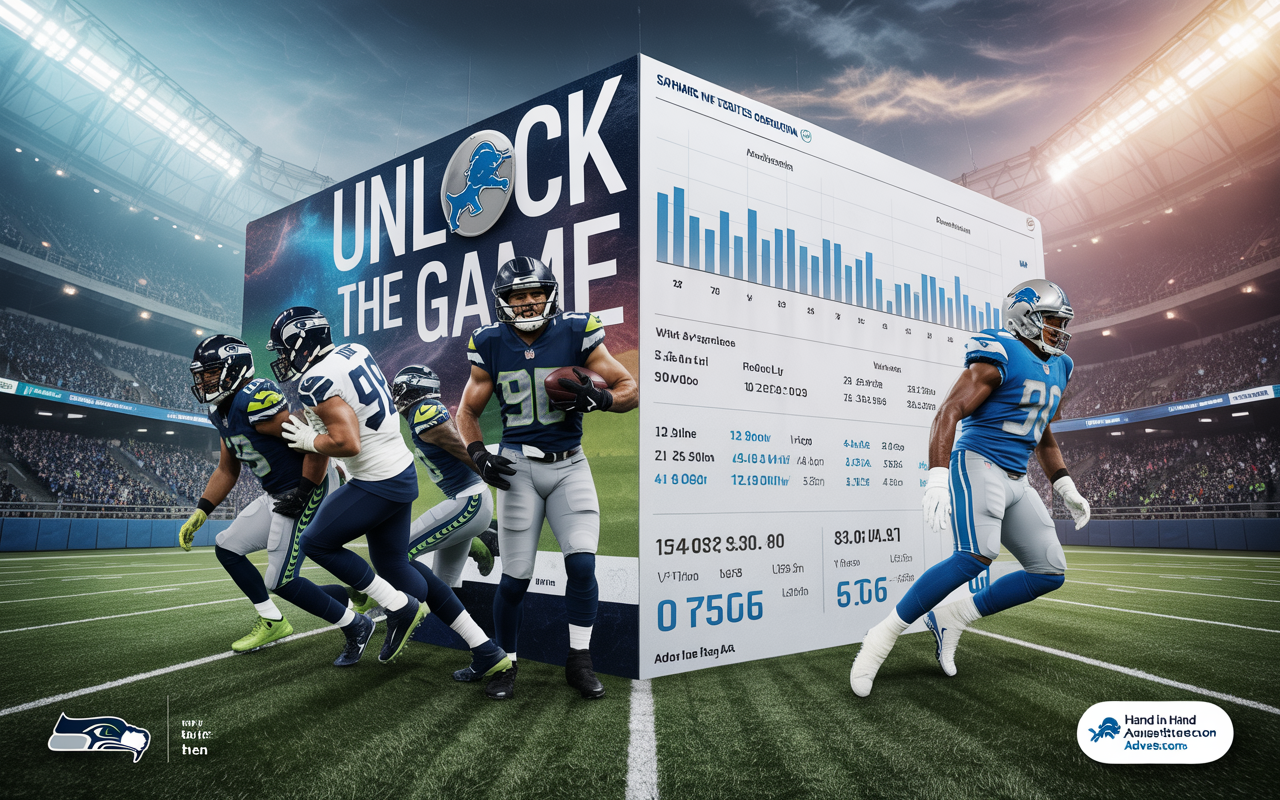When it comes to NFL matchups that capture the essence of competition, the Seahawks vs Detroit Lions Match Player Stats reveal not only raw talent but also strategic brilliance. This contest wasn’t just another regular-season game—it was a chess match played with helmets and heart. Every yard, every pass, every touchdown told a story of two teams striving for dominance. In this in-depth analysis, the performances of key players from both sides are examined, shedding light on the defining moments that shaped the game.
Seahawks vs Detroit Lions Match Player Stats Overview
The Seahawks vs Detroit Lions Match Player Stats showcased an intense battle between offense and defense. Seattle gained an impressive 516 total yards, while Detroit put up a commendable 389 yards. The Seahawks’ consistency in both aerial and ground attacks gave them the upper hand in time of possession, holding the ball for over 34 minutes. On the other hand, Detroit displayed efficiency and composure through Jared Goff’s flawless execution and the team’s ability to convert critical downs. This matchup became a highlight reel of athleticism, resilience, and tactical precision.
Geno Smith’s Commanding Presence for Seattle
Geno Smith’s performance defined Seattle’s offensive tempo. Completing 38 of 56 passes for 395 yards, he not only controlled the flow of the game but also demonstrated poise under pressure. Despite throwing one interception, Smith’s ability to spread the ball across multiple receivers kept Detroit’s defense guessing. His synergy with wideouts like DK Metcalf and Tyler Lockett turned several drives into scoring opportunities. It was a masterclass in patience and execution, proving once again why Smith remains a reliable play-caller for the Seahawks.
Jared Goff’s Perfect Performance for Detroit
On the other sideline, Jared Goff delivered a nearly flawless performance, completing all 18 of his passes for 292 yards and two touchdowns. His precision and timing made him a nightmare for Seattle’s secondary. What made Goff’s outing remarkable was his efficiency—every throw counted, every decision was calculated. Supported by a dynamic receiving corps led by Amon-Ra St. Brown, Goff’s leadership underlined Detroit’s offensive discipline and adaptability, even when pressured by Seattle’s defensive front.
Kenneth Walker III Dominates the Ground Game
Kenneth Walker III was the heartbeat of Seattle’s rushing attack. With 12 carries for 80 yards and three touchdowns, he carved through Detroit’s defensive line with determination. Each run was a statement, powered by quick acceleration and outstanding vision. His ability to find gaps in the defense not only secured critical first downs but also kept the Lions’ defense honest, forcing them to respect Seattle’s dual-threat offensive strategy.
Jahmyr Gibbs Shines Bright for the Lions
Jahmyr Gibbs emerged as Detroit’s most dynamic weapon on the ground. Rushing for 78 yards and scoring twice, his explosiveness and agility were on full display. Gibbs’ ability to evade tackles and extend plays demonstrated his potential as one of the league’s rising stars. Every time he touched the ball, the energy in the stadium shifted. The combination of speed and control he displayed showed why Detroit’s coaching staff continues to place their trust in his growing talent.
Wide Receiver Brilliance: DK Metcalf and Amon-Ra St. Brown
Both DK Metcalf and Amon-Ra St. Brown were instrumental in their teams’ offensive success. Metcalf recorded 104 receiving yards on seven catches, stretching the field and challenging Detroit’s cornerbacks on deep routes. His physical dominance and reliable hands made him a constant target for Smith. Meanwhile, St. Brown brought finesse and precision to the Lions’ passing game, hauling in six receptions for 45 yards and a touchdown. His route-running was pristine, often leaving defenders a step behind. Together, these receivers turned the game into a showcase of elite-level talent.
Emergence of Jaxon Smith-Njigba and Sam LaPorta
The younger talents also left their mark. Jaxon Smith-Njigba, Seattle’s rookie sensation, contributed eight catches for 51 yards, showing remarkable maturity and route discipline. His ability to create separation in tight coverage added a new layer to Seattle’s offensive playbook. For Detroit, tight end Sam LaPorta was equally impressive with four receptions for 53 yards. His versatility as both a blocker and a receiver gave Goff a reliable safety valve in critical moments.
Defensive Highlights and Key Stops
While the offensive plays stole the spotlight, the defenses of both teams had defining moments. Seattle’s defensive line disrupted Goff’s rhythm early on, applying consistent pressure. Meanwhile, Detroit’s Kerby Joseph recorded an interception that temporarily shifted momentum. Carlton Davis III forced a fumble, displaying Detroit’s aggressive defensive mindset. The linebackers on both sides showcased tactical awareness, preventing explosive plays and tightening red-zone coverage when it mattered most.
Turnovers and Tactical Adjustments
Turnovers often decide the outcome of close games, and this matchup was no exception. Seattle lost one fumble, while Detroit’s turnover came at a crucial juncture. Each team adjusted quickly, turning defensive lapses into opportunities for redemption. What stood out was how both coaching staffs reacted—Seattle emphasizing possession control, and Detroit pushing tempo to regain momentum. Such adaptability reflected the experience and strategic thinking of both head coaches.
Special Teams: The Unsung Heroes
Special teams played an underrated yet vital role. Seattle’s kick return unit gained 54 yards on two returns, while Detroit managed 26 yards on a single return. Punting accuracy, field goals, and coverage units quietly shaped field position battles. These small details often go unnoticed, but they influence game tempo and scoring chances significantly.
Coaching Mastery and Game Strategy
Coaching decisions were at the core of this thrilling encounter. Pete Carroll’s emphasis on balance between run and pass gave Seattle the versatility to adapt to defensive looks. On the other hand, Dan Campbell’s aggressive play-calling—especially on fourth downs—reflected Detroit’s fearless approach. Both coaches exhibited adaptability, understanding when to push and when to hold back. This balance between strategy and instinct turned the Seahawks vs Detroit Lions Match Player Stats into a tactical masterpiece.
Comparing Offensive Efficiency
Statistically, Seattle’s offense outperformed Detroit in yardage and time of possession. However, Detroit’s efficiency in the red zone kept the game competitive. While Seattle moved the ball more freely, Detroit capitalized on its scoring chances with surgical precision. This contrast between volume and efficiency underscored two distinct offensive philosophies—Seattle’s methodical drive-building and Detroit’s quick-strike capability.
Defensive Breakdown and Pressure Rates
Seattle’s front seven applied consistent pressure, with multiple quarterback hurries that disrupted Goff’s rhythm despite his perfect completion rate. Detroit’s defense countered by tightening coverage and forcing Geno Smith into tighter passing windows. The defensive linemen from both teams displayed endurance and adaptability, proving that even when stats highlight offense, the trenches often determine the game’s true outcome.
Impact of Penalties and Discipline
Discipline proved decisive. Seattle committed eight penalties totaling 70 yards, while Detroit had twelve penalties for 101 yards. These infractions often halted momentum and altered field position. The difference in composure was noticeable—Seattle remained poised in critical moments, while Detroit’s costly penalties extended several of Seattle’s drives. Maintaining composure under pressure remains a hallmark of seasoned teams, and it was evident here.
Time of Possession and Game Control
The clock told its own story. Seattle controlled possession for 34 minutes compared to Detroit’s 26. This advantage allowed the Seahawks to dictate tempo, wear down Detroit’s defense, and manage the game’s rhythm. It also reflected Seattle’s commitment to sustaining drives and protecting the ball. Meanwhile, Detroit’s quicker scoring sequences emphasized explosive potential rather than prolonged control.
Player Chemistry and Locker Room Unity
Team chemistry played a vital role. Seattle’s cohesion between offensive units—particularly between Smith and his receivers—was evident. Communication on the line of scrimmage and execution of plays flowed seamlessly. Detroit’s unity shone through in moments of adversity, where players rallied behind one another after setbacks. This intangible quality often defines long-term success in professional football.
Fan Reactions and Stadium Energy
The atmosphere was electric. Fans from both sides created an environment that amplified every big play. Seahawks supporters erupted during Walker’s touchdowns, while Lions fans roared with every Goff completion. The passion in the stands mirrored the intensity on the field, proving that football remains as much about emotion as execution.
Statistical Comparison Summary
| Category | Seattle Seahawks | Detroit Lions |
|---|---|---|
| Total Yards | 516 | 389 |
| Passing Yards | 395 | 292 |
| Rushing Yards | 121 | 97 |
| Turnovers | 1 | 1 |
| Time of Possession | 34:04 | 25:56 |
| Penalties | 8 (70 yards) | 12 (101 yards) |
| This table highlights the statistical edge Seattle maintained throughout the matchup, especially in total yardage and possession control, although Detroit’s red-zone efficiency kept the game tight. |
Leadership on and off the Field
Leadership was evident from both sidelines. Geno Smith’s composure inspired his offense, while Jared Goff’s calm demeanor kept Detroit focused. Defensive captains ensured coordination during high-pressure moments. Both teams displayed resilience—a testament to the culture built by their coaching staff.
Learning from the Match
For Seattle, the key takeaway was the balance between aggressive play-calling and disciplined execution. Detroit, on the other hand, learned the importance of reducing penalties and maintaining momentum during prolonged drives. Both teams walked away with lessons that would influence their midseason adjustments.
The Emotional Momentum Shifts
Momentum in football is intangible yet powerful. Seattle’s early dominance gave them confidence, but Detroit’s quick scores reignited competition. Each touchdown changed the emotional pulse of the crowd and the players. These moments revealed how critical psychology is in shaping performance under pressure.
Future Implications for Both Teams
The Seahawks vs Detroit Lions Match Player Stats not only reflect one game but also indicate potential trends for the season ahead. Seattle’s ability to execute balanced offense positions them as contenders in the NFC West. Detroit’s resilience and emerging stars like Gibbs and St. Brown signal a bright future. Both franchises are evolving, learning, and preparing to redefine their identities in the upcoming matchups.
Conclusion
The Seahawks vs Detroit Lions Match Player Stats paint a vivid picture of two teams locked in strategic brilliance. From Geno Smith’s leadership to Jared Goff’s perfection, from Walker’s ground dominance to Gibbs’ electrifying runs, every performance contributed to a narrative of determination and skill. Football fans witnessed a spectacle that celebrated precision, perseverance, and passion. Ultimately, it wasn’t just about who won—it was about the relentless pursuit of excellence displayed by both sides.

